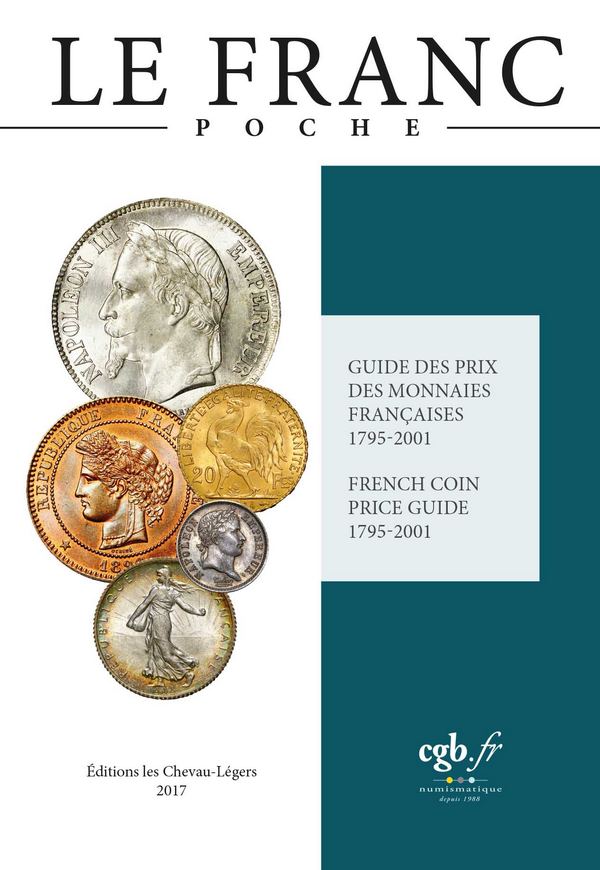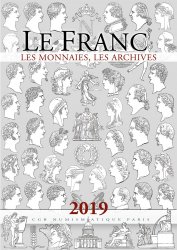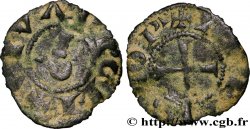lf2017 - LE FRANC, les Monnaies - édition poche 2017 sous la direction de Joël Cornu
Non disponible.
Article vendu sur notre boutique internet (2022)
Prix : 14.90 €
Article vendu sur notre boutique internet (2022)
Prix : 14.90 €
Auteur : sous la direction de Joël Cornu
Editeur : CGF
Langue : anglais / français
Caractéristiques : Paris, 2016, (10,5 x 15,5 cm), 592 p., cotes pour six états de conservation et photographies avers et revers de tous les types monétaires en couleur, correspondance avec « La Collection Idéale »
Poids : 420 g.
Commentaire
FRANC POCHE 2017
Après 240.000 exemplaires vendus en France, il était temps de s'ouvrir aux collectionneurs du monde entier. L'ouvrage LE FRANC, constitue désormais un ouvrage de référence incontournable pour tous les professionnels et collectionneurs de monnaies françaises.
L'audience visée est multiple, bien au-delà du cercle des collectionneurs de monnaies françaises : le grand public, le numismate débutant, chevronné ou professionnel, l'antiquaire, le passionné d'Histoire etc. Le public concerné est lui international. La Numismatique est désormais ouverte sur le monde. La révolution internet et des réseaux sociaux est passé par là. Ainsi cette nouvelle édition sera bilingue, français et anglais. Le patrimoine numismatique français étant immense et recherché également au delà de nos frontières.
Pourquoi faire un Franc Poche plutôt qu’une mise à jour du Franc 10 ?
- répondre aux besoins des collectionneurs chevronnés. Parce que la collection LE FRANC est une véritable encyclopédie numismatique que l’on conserve chez soi, le numismate a besoin d’avoir en plus de celle-ci, une version condensée et pratique pour ses déplacements.
- répondre aux demandes des jeunes collectionneurs qui trouvent souvent l’approche encyclopédique du FRANC trop compliquée, trop dense, trop fastidieuse.
- répondre à la demande des collectionneurs étrangers de monnaies modernes françaises en publiant un ouvrage entièrement bilingue, français et anglais.
- répondre au mécontentement des collectionneurs suite à la suppression des nombreux types depuis les versions précédentes et cela malgré la consultation organisée auprès des collectionneurs en août 2012.
Le FRANC POCHE est un véritable ouvrage de synthèse puisqu'il réunit à lui seul tous les types monétaires des versions précédentes du FRANC. Lorsque vous serez gymnastiqué avec les arcanes du FRANC POCHE, vous pourrez franchir une nouvelle étape et ainsi investir dans la version encyclopédique du FRANC.
La refonte du FRANC POCHE ne s'arrête évidemment pas aux nouveaux types. Comme dans les dernières éditions, il y a des lignes rajoutées en fonction des découvertes et des recherches réalisées et des lignes supprimées faute de confirmation. Le gros des nouvelles lignes se regroupe, comme toujours, autour des Dupré, argent et cuivre. Cette fois-ci un énorme travail en Archives a également été réalisé par Philippe Théret au niveau des divisionnaires de Louis-Philippe.
Une fois les fusions des types discutés et décidés, et une fois les ajouts de lignes opérés place à l'établissement des cotes. Le FRANC POCHE regroupe plus de 30.000 cotes à jour et vérifiées par une réunion de numismates passionnés et professionnels.
En 2016, place donc au FRANC POCHE ! Nouveau format, nouvelle approche, nouveau prix.
Vous y retrouverez les cotes à jour pour tous les types, toutes les variétés, les notes les plus importantes, des photos en couleurs de très grande qualité. Un nouvel outil de collection facile à emporter, à consulter, complet et sérieux.
Après 240.000 exemplaires vendus en France, il était temps de s'ouvrir aux collectionneurs du monde entier. L'ouvrage LE FRANC, constitue désormais un ouvrage de référence incontournable pour tous les professionnels et collectionneurs de monnaies françaises.
L'audience visée est multiple, bien au-delà du cercle des collectionneurs de monnaies françaises : le grand public, le numismate débutant, chevronné ou professionnel, l'antiquaire, le passionné d'Histoire etc. Le public concerné est lui international. La Numismatique est désormais ouverte sur le monde. La révolution internet et des réseaux sociaux est passé par là. Ainsi cette nouvelle édition sera bilingue, français et anglais. Le patrimoine numismatique français étant immense et recherché également au delà de nos frontières.
Pourquoi faire un Franc Poche plutôt qu’une mise à jour du Franc 10 ?
- répondre aux besoins des collectionneurs chevronnés. Parce que la collection LE FRANC est une véritable encyclopédie numismatique que l’on conserve chez soi, le numismate a besoin d’avoir en plus de celle-ci, une version condensée et pratique pour ses déplacements.
- répondre aux demandes des jeunes collectionneurs qui trouvent souvent l’approche encyclopédique du FRANC trop compliquée, trop dense, trop fastidieuse.
- répondre à la demande des collectionneurs étrangers de monnaies modernes françaises en publiant un ouvrage entièrement bilingue, français et anglais.
- répondre au mécontentement des collectionneurs suite à la suppression des nombreux types depuis les versions précédentes et cela malgré la consultation organisée auprès des collectionneurs en août 2012.
Le FRANC POCHE est un véritable ouvrage de synthèse puisqu'il réunit à lui seul tous les types monétaires des versions précédentes du FRANC. Lorsque vous serez gymnastiqué avec les arcanes du FRANC POCHE, vous pourrez franchir une nouvelle étape et ainsi investir dans la version encyclopédique du FRANC.
La refonte du FRANC POCHE ne s'arrête évidemment pas aux nouveaux types. Comme dans les dernières éditions, il y a des lignes rajoutées en fonction des découvertes et des recherches réalisées et des lignes supprimées faute de confirmation. Le gros des nouvelles lignes se regroupe, comme toujours, autour des Dupré, argent et cuivre. Cette fois-ci un énorme travail en Archives a également été réalisé par Philippe Théret au niveau des divisionnaires de Louis-Philippe.
Une fois les fusions des types discutés et décidés, et une fois les ajouts de lignes opérés place à l'établissement des cotes. Le FRANC POCHE regroupe plus de 30.000 cotes à jour et vérifiées par une réunion de numismates passionnés et professionnels.
En 2016, place donc au FRANC POCHE ! Nouveau format, nouvelle approche, nouveau prix.
Vous y retrouverez les cotes à jour pour tous les types, toutes les variétés, les notes les plus importantes, des photos en couleurs de très grande qualité. Un nouvel outil de collection facile à emporter, à consulter, complet et sérieux.
Article
This book represents a serious attempt to apply American grading standards to French coins, and assign realistic corresponding market values. It is no secret that a great number of French coins are of greater rarity in mint state than similar coins of other countries. LE FRANC endeavors to provide market prices for French coins in choice mint state that were simply unavailable (when available at all) at the unrealistic levels listed in previous publication. It is hoped that the high prices listed for French coins in choice uncirculated condition will inspire the domestic French market to be more discerning in their grading. This book is an open challenge to French numismatists for them to examine modern (say, coins of Napoleon to date) coins with American eyes.
For years, many American collectors of French coins have baffled French dealers with their seemingly arbitrary grading whims. The reason for this lies not with any fault in the French, but rather with numismatics in the United States. Very few American coins are of real absolute rarity. The vast American collector market focuses, therefore, on quality. The large number of American coins minted permits Americans collectors to be very selective: they are very demanding when it comes to grade of preservation. To call a coin “nice uncirculated” isn’t enough. The American collector wants to know: not just how nice, but exactly how nice. This has led to the numerical mint state grading system which has caused so much confusion in other countries. Many French coins are so rare in high grade that not enough of them have been on the market for there to be a set price structure. A coin described as “SUP à FDC” could well be the finest anyone has seen in years of a given issue, and therefore no one in France asks if it would be the equivalent of an American AU-58 or an American MS-65. The fact is, however, that it does matter.
The world is getting smaller, and contact among numismatists of all countries will only increase. French coins are enormously popular in the United States and Japan, as well as to a lesser degree in Germany and Switzerland. The huge price swings in American coins, depending on their grade, is practically universally known. These price swings do not yet exist in the domestic market for French coins. It is only a question of time before this situation changes.
The market in the United States has already adapted its own standards to its pricing for high quality French coins. Small increases in the quality of an uncirculated coin can mean a large increase in that coin’s price. French dealers will note this and take advantage of it, if only for purely economic reasons. French collectors will soon do likewise, or else watch their best coins go into collections in other countries. This book, by French numismatists familiar with American coins and the American coin market, is an attempt to bring the future of French numismatics a little closer. Its intention is to put the domestic French market on an equal footing with its American counterpart and show, to quote Marvin Gaye, “what’s goin’on.”
Respectfully submitted
Marc D. Emory
marcemory@HA.com
Director of Overseas Operations
Heritage Rare Coin Galleries
Dallas, Texas, U.S.A.
http://www.HA.com/
It has long been taken for granted that price guides and reference books on coins, while useful to the hobbyist, were usually quite dry in both content and appearance. Lacking color, design aesthetics or useful advice to the novice, they were purely functional vehicles, providing the pricing or identification information in a straightforward though bland format.
The 21st century is the Internet Age, and whether the use of color, attractive design or eye appeal has become more important may be a matter of debate, it cannot be argued that the new Le Franc Poche edition is a stunning and innovative new approach to a coin reference book.
The pricing section makes use of large, full color photographs of superb quality for each type, along with all vital statistics (in both French and English) such as size, weight, purity, edge and total mintage for the type. Beneath that, are grading guidelines in six grades, again, in both French and English. Pricing information follows, in six grades, for each date and mint. Bold prices in red indicate values for coins shown in “The Ideal Collection”, an online collection maintained by CGB of the finest specimens of each issue they have identified to date. Pricing column headings are color coordinated to match the grading descriptions shown above, adding not only visual attractiveness but clarity as well.
CGB has long been at the forefront in adopting the numeric Sheldon Grading System for French coins. While not perfect, it does add significantly greater structure to grading than the preceding system. Additionally, over the past thirty years, third-party grading services have leveled the playing field and provided increased transparency to the numismatic market.
After the standard listings for Copper, Silver and Gold issues, the book continues with the various Mint and Proof sets (Fleurs de Coins, Belle Épreuve et BU) issued by the Paris Mint from 1964 through the final issue in 2001. Sharp, clear, color photos assist collectors in identifying which particular set they have.
If the book contained only identification and pricing information, it would be extremely useful. But the staff of CGB has long been committed to both educating the collecting public as well as “spreading the gospel” of numismatics to a new, and hopefully younger generation of collectors. To that end, Le Franc Poche contains a plethora of introductory and educational material including a brief history of French coinage, a complete review of the Privy Marks used by both the General Engravers and the Mint Directors, an illustrated glossary, tips and advice on collecting French coins and finally guidelines on how to take further steps in your quest for more numismatic knowledge.
It is both encouraging and refreshing to see a numismatic firm take such a far-sighted and effective step towards explaining and expanding the coin-collecting hobby. Far too many dealers simply buy and sell, paying little heed towards the education of the collector or the future of the hobby. CGB has taken a major step towards encouraging new collectors as well as invigorating existing ones.
Whether you’re a novice, an intermediate collector or even an advanced numismatist needing a quick and handy reference, you’ll find Le Franc Poche excels in every aspect of a useful guide and fulfills its stated purpose admirably.
Michael W. Sherman
Director of Education
Professional Coin Grading Service (PCGS).
For years, many American collectors of French coins have baffled French dealers with their seemingly arbitrary grading whims. The reason for this lies not with any fault in the French, but rather with numismatics in the United States. Very few American coins are of real absolute rarity. The vast American collector market focuses, therefore, on quality. The large number of American coins minted permits Americans collectors to be very selective: they are very demanding when it comes to grade of preservation. To call a coin “nice uncirculated” isn’t enough. The American collector wants to know: not just how nice, but exactly how nice. This has led to the numerical mint state grading system which has caused so much confusion in other countries. Many French coins are so rare in high grade that not enough of them have been on the market for there to be a set price structure. A coin described as “SUP à FDC” could well be the finest anyone has seen in years of a given issue, and therefore no one in France asks if it would be the equivalent of an American AU-58 or an American MS-65. The fact is, however, that it does matter.
The world is getting smaller, and contact among numismatists of all countries will only increase. French coins are enormously popular in the United States and Japan, as well as to a lesser degree in Germany and Switzerland. The huge price swings in American coins, depending on their grade, is practically universally known. These price swings do not yet exist in the domestic market for French coins. It is only a question of time before this situation changes.
The market in the United States has already adapted its own standards to its pricing for high quality French coins. Small increases in the quality of an uncirculated coin can mean a large increase in that coin’s price. French dealers will note this and take advantage of it, if only for purely economic reasons. French collectors will soon do likewise, or else watch their best coins go into collections in other countries. This book, by French numismatists familiar with American coins and the American coin market, is an attempt to bring the future of French numismatics a little closer. Its intention is to put the domestic French market on an equal footing with its American counterpart and show, to quote Marvin Gaye, “what’s goin’on.”
Respectfully submitted
Marc D. Emory
marcemory@HA.com
Director of Overseas Operations
Heritage Rare Coin Galleries
Dallas, Texas, U.S.A.
http://www.HA.com/
It has long been taken for granted that price guides and reference books on coins, while useful to the hobbyist, were usually quite dry in both content and appearance. Lacking color, design aesthetics or useful advice to the novice, they were purely functional vehicles, providing the pricing or identification information in a straightforward though bland format.
The 21st century is the Internet Age, and whether the use of color, attractive design or eye appeal has become more important may be a matter of debate, it cannot be argued that the new Le Franc Poche edition is a stunning and innovative new approach to a coin reference book.
The pricing section makes use of large, full color photographs of superb quality for each type, along with all vital statistics (in both French and English) such as size, weight, purity, edge and total mintage for the type. Beneath that, are grading guidelines in six grades, again, in both French and English. Pricing information follows, in six grades, for each date and mint. Bold prices in red indicate values for coins shown in “The Ideal Collection”, an online collection maintained by CGB of the finest specimens of each issue they have identified to date. Pricing column headings are color coordinated to match the grading descriptions shown above, adding not only visual attractiveness but clarity as well.
CGB has long been at the forefront in adopting the numeric Sheldon Grading System for French coins. While not perfect, it does add significantly greater structure to grading than the preceding system. Additionally, over the past thirty years, third-party grading services have leveled the playing field and provided increased transparency to the numismatic market.
After the standard listings for Copper, Silver and Gold issues, the book continues with the various Mint and Proof sets (Fleurs de Coins, Belle Épreuve et BU) issued by the Paris Mint from 1964 through the final issue in 2001. Sharp, clear, color photos assist collectors in identifying which particular set they have.
If the book contained only identification and pricing information, it would be extremely useful. But the staff of CGB has long been committed to both educating the collecting public as well as “spreading the gospel” of numismatics to a new, and hopefully younger generation of collectors. To that end, Le Franc Poche contains a plethora of introductory and educational material including a brief history of French coinage, a complete review of the Privy Marks used by both the General Engravers and the Mint Directors, an illustrated glossary, tips and advice on collecting French coins and finally guidelines on how to take further steps in your quest for more numismatic knowledge.
It is both encouraging and refreshing to see a numismatic firm take such a far-sighted and effective step towards explaining and expanding the coin-collecting hobby. Far too many dealers simply buy and sell, paying little heed towards the education of the collector or the future of the hobby. CGB has taken a major step towards encouraging new collectors as well as invigorating existing ones.
Whether you’re a novice, an intermediate collector or even an advanced numismatist needing a quick and handy reference, you’ll find Le Franc Poche excels in every aspect of a useful guide and fulfills its stated purpose admirably.
Michael W. Sherman
Director of Education
Professional Coin Grading Service (PCGS).








 Cliquez ici pour feuilleter un extrait du livre
Cliquez ici pour feuilleter un extrait du livre Signaler une erreur
Signaler une erreur Imprimer la page
Imprimer la page Partager ma sélection
Partager ma sélection Poser une question
Poser une question
 Fiche
Fiche






